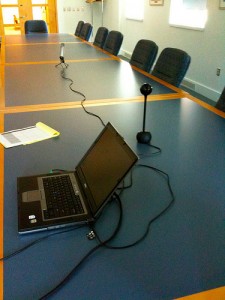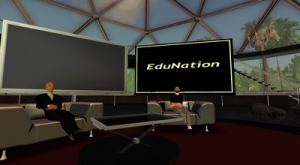[4 formats for running webinars]
Have you ever attended an online seminar or ‘webinar’? If so, did it follow
this pattern?
- introduction by moderator
- talk by presenter (with PowerPoint slides)
- question-and-answer time
Chances are that it did. This is a common format for a webinar, and an example of the chalk and talk presentation style, delivered online. It can also be the least engaging type of webinar.
So what other options do we have? Here is my webinar format guide, which currently includes four formats*. I’ve ordered them from the most straightforward to the more complex format (and given each a groovy name):
1 Chalk and talk
PowerPoint slides and presentation. Framed by an introduction from a moderator, and a question-and-answer slot at the end. There are ways to liven up this format, which I blog about here, but plenty of webinars I have attended don’t get any audience participation at all during the presentation stage. Added to this, there are unfortunately still some webinar platforms out there that only allow PowerPoint slides and voice. So no text chat window for participants to use as a back channel, or to socialise among themselves, or to respond to questions asked by the speaker. To me a webinar platform that allows no place for participants to interact with each other and the presenter should be shunned. We are in the age of Web 2.0 for Pete’s sake.
Basically an interview. The moderator interviews the speaker, possibly with pre-prepared questions, or questions which have been collected from the participants beforehand. The moderator should also be able to integrate relevant questions that are appearing in the chat window as the interview progresses. The advantage of this format is that participants are listening to two people speaking; the cut and thrust of real conversation makes listening far more engaging. The session can be rounded up with one of the short finishing activities mentioned here. A variation on the talk and talk format is the ‘Coffee with…’ format, where you get two subject experts shooting the breeze on a topic, in a less formal ambience. Doubly engaging. Here is an (audio) recording of a Coffee with.. session we ran with well-known language teaching experts, in Second Life (SL) last year. This recording is of Jeremy Harmer giving his first ever presentation in SL.
3 Listen and do
This is an effective webinar format if you would like participants to actually try out a tool for themselves during your presentation. Obviously, it is especially effective when you are talking about web-based tools. A few months back I gave a webinar about how to use a micro-blogging tool (Edmodo) in teacher training — and participants actually tried out Edmodo in the talk itself. You can hear me describe in 2 mins how the talk was structured – if you’re interested, take notes and you’ll have a webinar session plan!
4 Guided tour
Using shared browsing in the webinar platform, the presenter walks participants through a process, or a website. Especially effective for showing complex sites such as 3-D virtual worlds like Second Life to newcomers. It’s a good idea to stop broadcasting the presenter’s video when giving a guided tour, as it detracts from the shared browsing window. It also helps save bandwidth. The downside of shared web browsing is that not all webinar platforms are robust enough to support it. My own experience of shared web browsing has been patchy — sometimes it works fine, especially with smaller groups, but sometimes it can crash the platform. Make sure you try it out in the webinar platform a couple of times beforehand, if you are planning to use it.
What about you? Have you attended or given any webinars that follow other formats? Please add them to the comments section!
*Thanks to my the Consultants-E colleague Ana d’Almeida, who inspired me with ideas for this post through her recent work in writing a short online course for the British Council.
Nicky Hockly
The Consultants-E
June 2010


